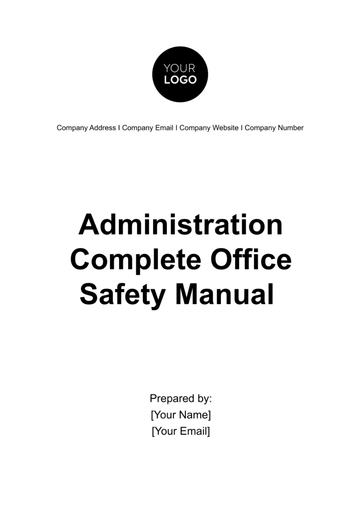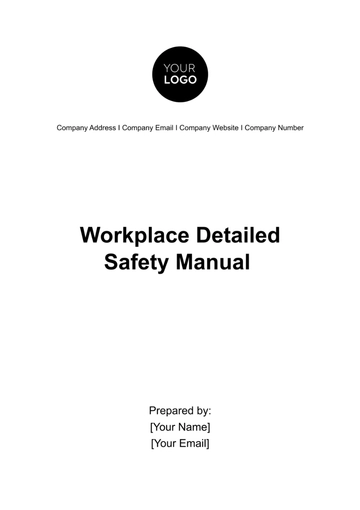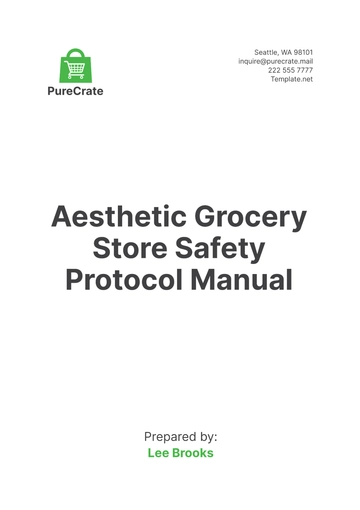Free Cleaning Services Health & Safety Training Manual

Welcome to the definitive guide for Cleaning Services provided by [YOUR COMPANY NAME]. Our commitment to excellence is reflected in our dedication to health and safety, ensuring the highest standards are met for both our employees and our valued clients. This manual is your comprehensive resource, outlining the essential guidelines and practices that underscore our service excellence.
I. Introduction
At [YOUR COMPANY NAME], we believe that a well-informed team is the backbone of superior service delivery. This training manual has been meticulously crafted to equip you with the vital knowledge and skills necessary to uphold our esteemed standards of service. It is imperative that each member of our team understands the significance of these guidelines and integrates them into their everyday work practices.
Our industry demands not only expertise in cleaning services but also a steadfast commitment to safety and health standards. The well-being of our employees and the satisfaction of our clients are intertwined with our operational practices. Therefore, we place great emphasis on adherence to the health and safety protocols detailed in this guide.
By following the procedures outlined in this manual, you contribute to a culture of safety and excellence that distinguishes [YOUR COMPANY NAME] in the cleaning services industry. Your dedication to maintaining these standards is not only a testament to your professionalism but also enhances the overall client experience, reinforcing their trust and confidence in our services.
II. Risk Assessment
At [YOUR COMPANY NAME], we prioritize the safety of our employees and clients by requiring a comprehensive risk assessment before any task. This crucial step ensures that potential dangers are evaluated and appropriate precautionary and mitigation strategies are developed.
The Risk Assessment Process:
Identify Hazards: Recognize potential hazards associated with the task at hand.
Evaluate Likelihood: Determine how likely it is for the risk to occur.
Identify Severity: Assess the potential impact or severity of the incident should it occur.
Implement Controls: Develop strategies to either eliminate the risk or manage it effectively.
Key Components of an Effective Risk Assessment:
Accident Incident Reporting: Information gathered is crucial for this reporting, aiding in preventing future incidents.
Documentation: Maintain detailed records of all risk assessments for reference and continuous improvement.
This systematic approach to risk assessment is fundamental in maintaining a safe working environment and is integral to our operations at [YOUR COMPANY NAME].
III. Personal Protective Equipment (PPE)
Personal Protective Equipment (PPE) is an essential safety component in our daily operations, safeguarding our employees from potential harm and ensuring the health of our clients.
Types of PPE and Their Maintenance:
Gloves: Protect hands from chemicals and infections.
Masks: Prevent inhalation of hazardous substances.
Protective Footwear: Shield feet from injuries due to falling objects or spills.
PPE Maintenance and Replacement:
Storage: PPE should be stored properly when not in use to maintain its condition.
Maintenance: Regular checks to ensure PPE is functional and clean.
Replacement: Any damaged PPE must be reported and replaced immediately.
Following these PPE protocols is not just about individual safety; it’s about fostering a culture of health and safety that extends to our clients and their environments.
IV. Chemical Handling
Handling cleaning chemicals safely is paramount for the protection of our employees and clients. At [YOUR COMPANY NAME], we adhere to strict guidelines to prevent accidents and ensure the safe use of these substances.
Understanding Chemicals:
Material Safety Data Sheets (MSDSs): Employees must familiarize themselves with MSDSs, which detail the hazards of a chemical and the recommended PPE.
Training: Regular training sessions on chemical safety and emergency response.
Proper Chemical Usage:
Dilution: Follow precise dilution ratios to ensure effectiveness and safety.
Transportation: Transport chemicals securely to prevent spills.
Storage: Store chemicals in labeled, secure locations away from incompatible substances.
Preventing Misuse:
Clear Instructions: Ensure all chemicals are accompanied by clear usage instructions.
Supervision: Monitor the use of hazardous chemicals, especially for new employees.
By adhering to these guidelines, [YOUR COMPANY NAME] minimizes the risks associated with chemical handling, ensuring a safe working environment for our team and a healthy environment for our clients.
V. Safe Manual Handling
Understanding and practicing safe manual handling techniques are crucial for preventing workplace injuries. Many tasks in the cleaning industry require the manual moving of objects, which, if done improperly, can lead to strains, sprains, and other musculoskeletal disorders.
Key Guidelines for Safe Manual Handling:
Proper Lifting Techniques: Always bend at the knees, not the waist, to lift an object. Ensure a stable stance and hold the load close to your body to minimize strain.
Avoid Twisting Movements: When carrying a load, turn your whole body instead of twisting at the waist to prevent back injuries.
Use of Equipment: Where possible, use trolleys, carts, or other mechanical aids to transport heavy or awkward loads.
Team Lifts: For loads that are too heavy or bulky for one person, always seek assistance from a colleague. A coordinated effort reduces the risk of injury.
Educating our team on these practices is a priority, ensuring that manual handling tasks are performed safely and efficiently.
VI. Emergency Procedures
Emergencies can arise unexpectedly, and the preparedness of our staff can make a significant difference in preventing harm and minimizing damage. [YOUR COMPANY NAME] has established clear procedures for responding to various emergency situations, including fires, chemical spills, and injuries.
Essential Emergency Response Strategies:
Knowledge of Evacuation Routes: Employees must be familiar with all available evacuation routes to ensure a quick and orderly exit during emergencies.
Location of Muster Points: Understanding where to assemble after evacuating the premises is crucial for accounting for all personnel.
Accessibility of First Aid and Safety Equipment: First aid kits, fire extinguishers, spill kits, and other safety equipment should be easily accessible to all staff members. Regular training is provided to ensure employees know how to use these resources effectively.
Prompt and efficient action in the face of emergencies protects both staff and clients, underscoring our commitment to safety at every level.
VII. Equipment Safety
The safe operation of cleaning equipment is vital not only for the protection of our employees but also for the integrity and longevity of the equipment itself. At [YOUR COMPANY NAME], we enforce strict guidelines to ensure that all cleaning equipment is used correctly and safely.
Ensuring Equipment Safety:
Training: Only employees who have received specific training are authorized to operate specialized cleaning equipment. This training covers safe operation, potential hazards, and emergency shutdown procedures.
Regular Maintenance: Adhering to the manufacturer's maintenance schedule is mandatory to keep equipment in optimal working condition and prevent malfunctions.
Damage and Malfunction Reporting: Employees are required to report any signs of damage or malfunction immediately. Prompt action can prevent accidents and costly repairs.
By emphasizing equipment safety, we not only protect our employees from potential harm but also ensure that our cleaning services are performed with the utmost efficiency and effectiveness.
VIII. Infection Control
[YOUR COMPANY NAME] places paramount importance on infection control. Our rigorous standards of hygiene and cleanliness are not merely operational requirements; they are our commitment to safeguarding the health of our clients and their environments. Infection control is a multifaceted approach that encompasses a variety of practices, aimed at minimizing the risk of infection transmission.
Essential Infection Control Practices:
Proper Waste Handling: Training in the correct disposal and handling of hazardous and non-hazardous waste to prevent the risk of infection.
Handwashing Protocols: Regular and thorough handwashing with soap and water or using an alcohol-based hand sanitizer to prevent cross-contamination.
Use of Disinfectants: Employing appropriate disinfectants to clean surfaces, especially those frequently touched, to kill pathogens effectively.
Personal Protective Equipment (PPE): Utilizing gloves, masks, and other protective gear when necessary to reduce exposure to infectious agents.
By meticulously adhering to these practices, our employees play a crucial role in preventing the spread of infections within client premises. Your dedication to these protocols ensures a safer, healthier environment for everyone.
IX. Reporting and Documentation
Accurate reporting and documentation are cornerstone practices at [YOUR COMPANY NAME], essential for the continuous maintenance of a safe and efficient workplace. This process not only helps in tracking incidents but also in developing strategies to prevent future occurrences.
Reporting and Documentation Guidelines:
Immediate Reporting: All incidents, regardless of their severity, must be reported to a supervisor immediately.
Detailed Documentation: Incident reports should be detailed, including the time, date, nature of the incident, and any actions taken in response.
Honesty in Reporting: It is crucial that all reports are honest and accurate, to ensure the integrity of our safety protocols.
Learning from Incidents: Documented incidents are reviewed regularly to identify patterns and develop preventative measures.
This proactive approach to reporting and documentation enhances our ability to maintain a safe work environment and fosters a culture of transparency and continuous improvement.
X. Seeking Help and Support
At [YOUR COMPANY NAME], we recognize that clarity and confidence in performing your duties are foundational to your success and our collective achievement. We encourage an environment where questions are welcomed and support is readily available, ensuring that every team member feels valued and equipped to perform their role to the best of their ability.
Channels for Assistance:
Direct Support: Always have [YOUR COMPANY NUMBER] and [YOUR COMPANY EMAIL] handy for immediate assistance with any queries or concerns.
Training and Resources: Access to ongoing training and resources to deepen your understanding and skills in your role.
Open Door Policy: Our management team maintains an open-door policy, inviting any discussions that can enhance your work experience or address any uncertainties.
By fostering this supportive environment, [YOUR COMPANY NAME] ensures that every employee has the tools and resources they need to excel in their roles, contributing to our reputation for excellence in the cleaning industry.
Together, these final chapters on infection control, reporting and documentation, and seeking help and support, encapsulate the essence of our Health & Safety Training Manual at [YOUR COMPANY NAME]. They underline our unwavering commitment to the highest standards of hygiene, safety, and employee empowerment. By integrating these principles into your daily work practices, you contribute to a culture of excellence that defines our brand. This manual is not just a document but a testament to our dedication to ensuring a safe, healthy, and supportive workplace for all employees and delivering unparalleled service to our clients.
- 100% Customizable, free editor
- Access 1 Million+ Templates, photo’s & graphics
- Download or share as a template
- Click and replace photos, graphics, text, backgrounds
- Resize, crop, AI write & more
- Access advanced editor
Empower your cleaning services team with our Health & Safety Training Manual Template. This essential resource from Template.net facilitates comprehensive training on safety protocols and procedures. Customize the manual effortlessly using our AI editor tool to align with your specific requirements. Equip your team with essential knowledge and skills to ensure compliance and minimize risks effectively. Elevate your safety standards and foster a secure working environment for all.





























